Airline Decision Making Scenarios
VerifiedAdded on 2020/05/16
|8
|1160
|84
AI Summary
This assignment presents three distinct scenarios involving an airline company faced with decisions regarding accepting special charter flights. Students must analyze the financial implications of each scenario, taking into account passenger revenue, cargo revenue, variable expenses, fixed costs, and potential environmental impacts. The goal is to determine the most profitable course of action for the airline in each situation, considering factors like spare capacity and future viability.
Contribute Materials
Your contribution can guide someone’s learning journey. Share your
documents today.
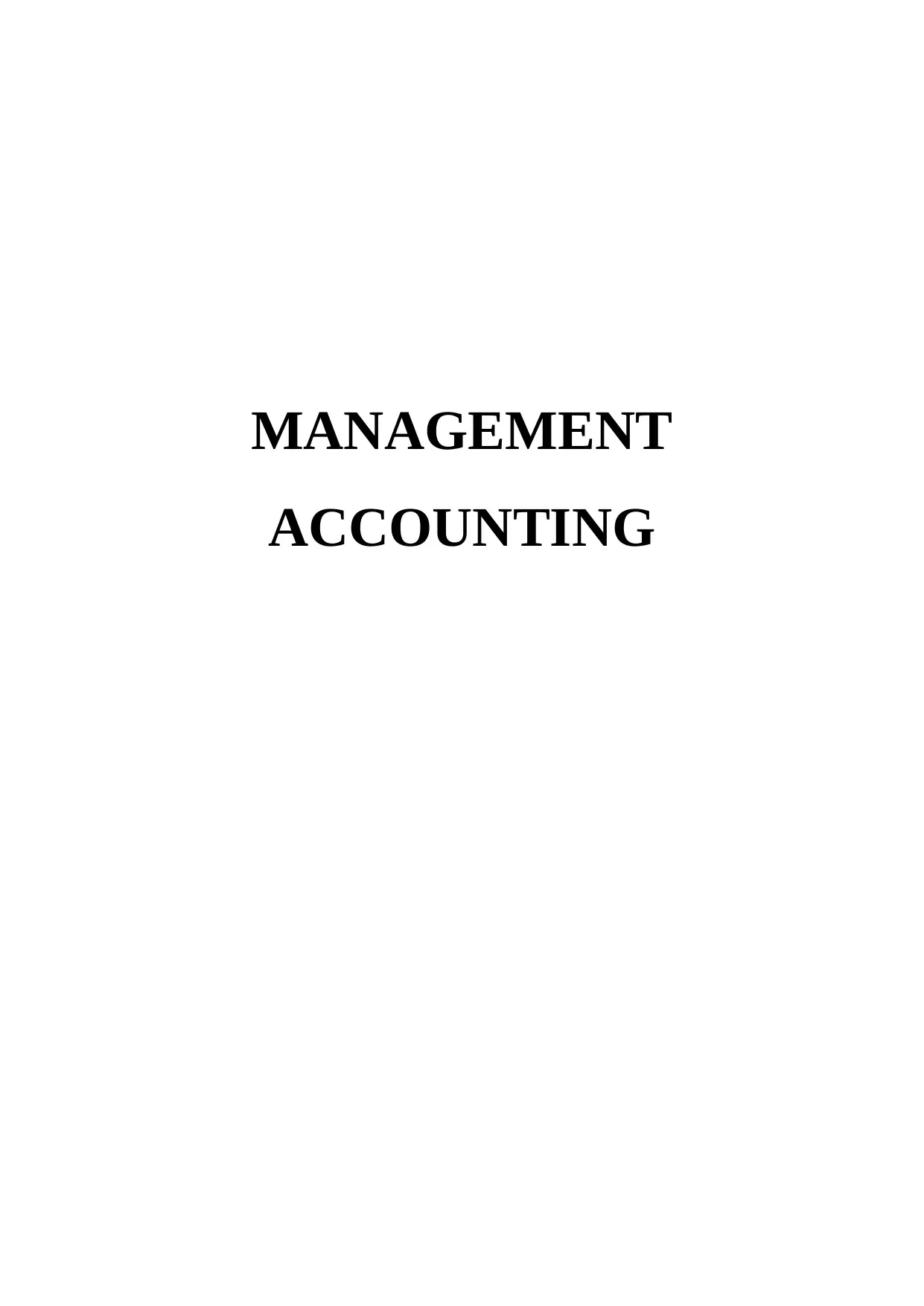
MANAGEMENT
ACCOUNTING
ACCOUNTING
Secure Best Marks with AI Grader
Need help grading? Try our AI Grader for instant feedback on your assignments.

Contents
Solution for Situation 1:.............................................................................................................3
Solution for Situation 2:.............................................................................................................5
Part a.......................................................................................................................................5
Part b.......................................................................................................................................5
Solution for Situation 3:.............................................................................................................7
Part a.......................................................................................................................................7
Part b.......................................................................................................................................7
Solution for Situation 1:.............................................................................................................3
Solution for Situation 2:.............................................................................................................5
Part a.......................................................................................................................................5
Part b.......................................................................................................................................5
Solution for Situation 3:.............................................................................................................7
Part a.......................................................................................................................................7
Part b.......................................................................................................................................7
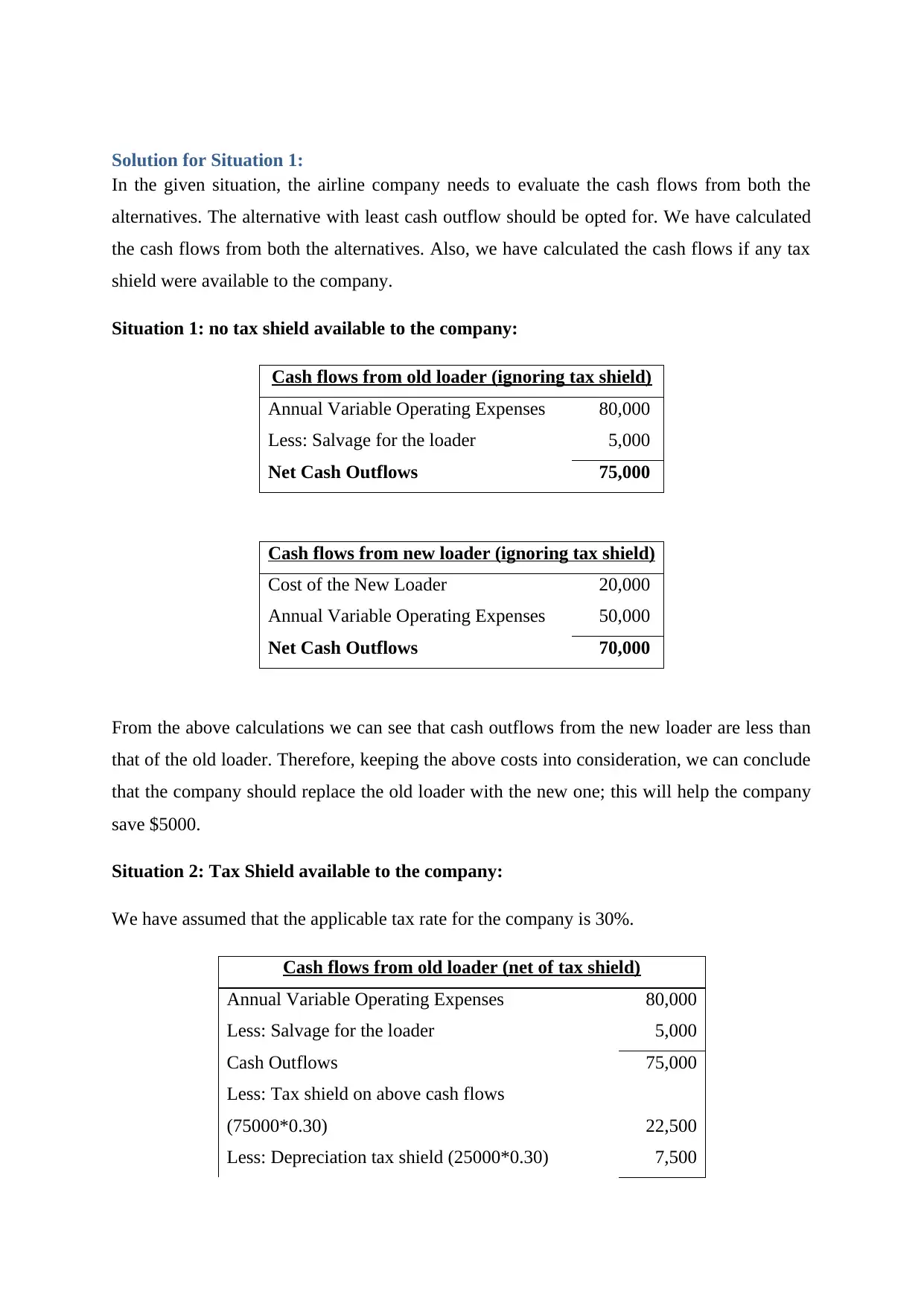
Solution for Situation 1:
In the given situation, the airline company needs to evaluate the cash flows from both the
alternatives. The alternative with least cash outflow should be opted for. We have calculated
the cash flows from both the alternatives. Also, we have calculated the cash flows if any tax
shield were available to the company.
Situation 1: no tax shield available to the company:
Cash flows from old loader (ignoring tax shield)
Annual Variable Operating Expenses 80,000
Less: Salvage for the loader 5,000
Net Cash Outflows 75,000
Cash flows from new loader (ignoring tax shield)
Cost of the New Loader 20,000
Annual Variable Operating Expenses 50,000
Net Cash Outflows 70,000
From the above calculations we can see that cash outflows from the new loader are less than
that of the old loader. Therefore, keeping the above costs into consideration, we can conclude
that the company should replace the old loader with the new one; this will help the company
save $5000.
Situation 2: Tax Shield available to the company:
We have assumed that the applicable tax rate for the company is 30%.
Cash flows from old loader (net of tax shield)
Annual Variable Operating Expenses 80,000
Less: Salvage for the loader 5,000
Cash Outflows 75,000
Less: Tax shield on above cash flows
(75000*0.30) 22,500
Less: Depreciation tax shield (25000*0.30) 7,500
In the given situation, the airline company needs to evaluate the cash flows from both the
alternatives. The alternative with least cash outflow should be opted for. We have calculated
the cash flows from both the alternatives. Also, we have calculated the cash flows if any tax
shield were available to the company.
Situation 1: no tax shield available to the company:
Cash flows from old loader (ignoring tax shield)
Annual Variable Operating Expenses 80,000
Less: Salvage for the loader 5,000
Net Cash Outflows 75,000
Cash flows from new loader (ignoring tax shield)
Cost of the New Loader 20,000
Annual Variable Operating Expenses 50,000
Net Cash Outflows 70,000
From the above calculations we can see that cash outflows from the new loader are less than
that of the old loader. Therefore, keeping the above costs into consideration, we can conclude
that the company should replace the old loader with the new one; this will help the company
save $5000.
Situation 2: Tax Shield available to the company:
We have assumed that the applicable tax rate for the company is 30%.
Cash flows from old loader (net of tax shield)
Annual Variable Operating Expenses 80,000
Less: Salvage for the loader 5,000
Cash Outflows 75,000
Less: Tax shield on above cash flows
(75000*0.30) 22,500
Less: Depreciation tax shield (25000*0.30) 7,500
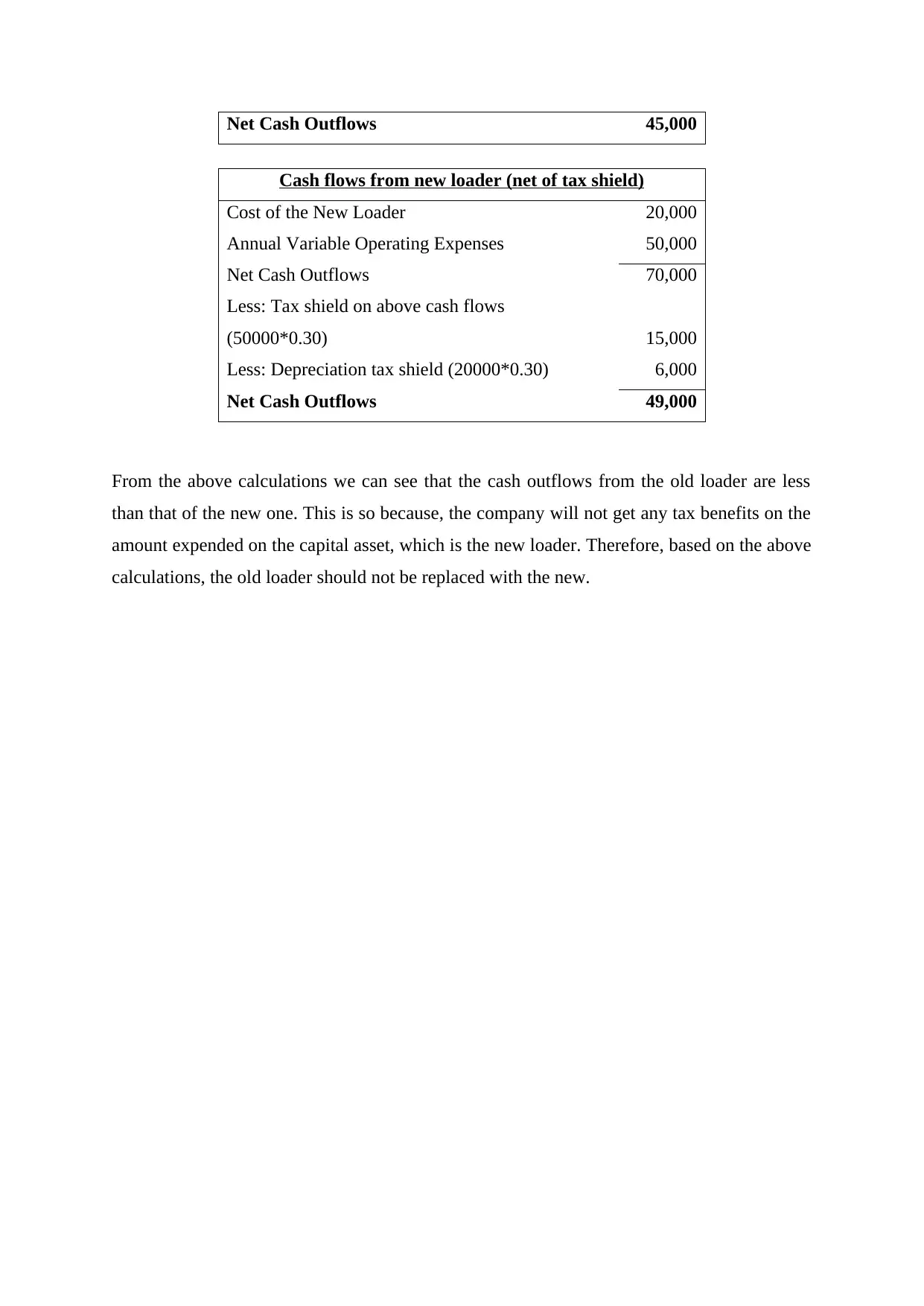
Net Cash Outflows 45,000
Cash flows from new loader (net of tax shield)
Cost of the New Loader 20,000
Annual Variable Operating Expenses 50,000
Net Cash Outflows 70,000
Less: Tax shield on above cash flows
(50000*0.30) 15,000
Less: Depreciation tax shield (20000*0.30) 6,000
Net Cash Outflows 49,000
From the above calculations we can see that the cash outflows from the old loader are less
than that of the new one. This is so because, the company will not get any tax benefits on the
amount expended on the capital asset, which is the new loader. Therefore, based on the above
calculations, the old loader should not be replaced with the new.
Cash flows from new loader (net of tax shield)
Cost of the New Loader 20,000
Annual Variable Operating Expenses 50,000
Net Cash Outflows 70,000
Less: Tax shield on above cash flows
(50000*0.30) 15,000
Less: Depreciation tax shield (20000*0.30) 6,000
Net Cash Outflows 49,000
From the above calculations we can see that the cash outflows from the old loader are less
than that of the new one. This is so because, the company will not get any tax benefits on the
amount expended on the capital asset, which is the new loader. Therefore, based on the above
calculations, the old loader should not be replaced with the new.
Secure Best Marks with AI Grader
Need help grading? Try our AI Grader for instant feedback on your assignments.
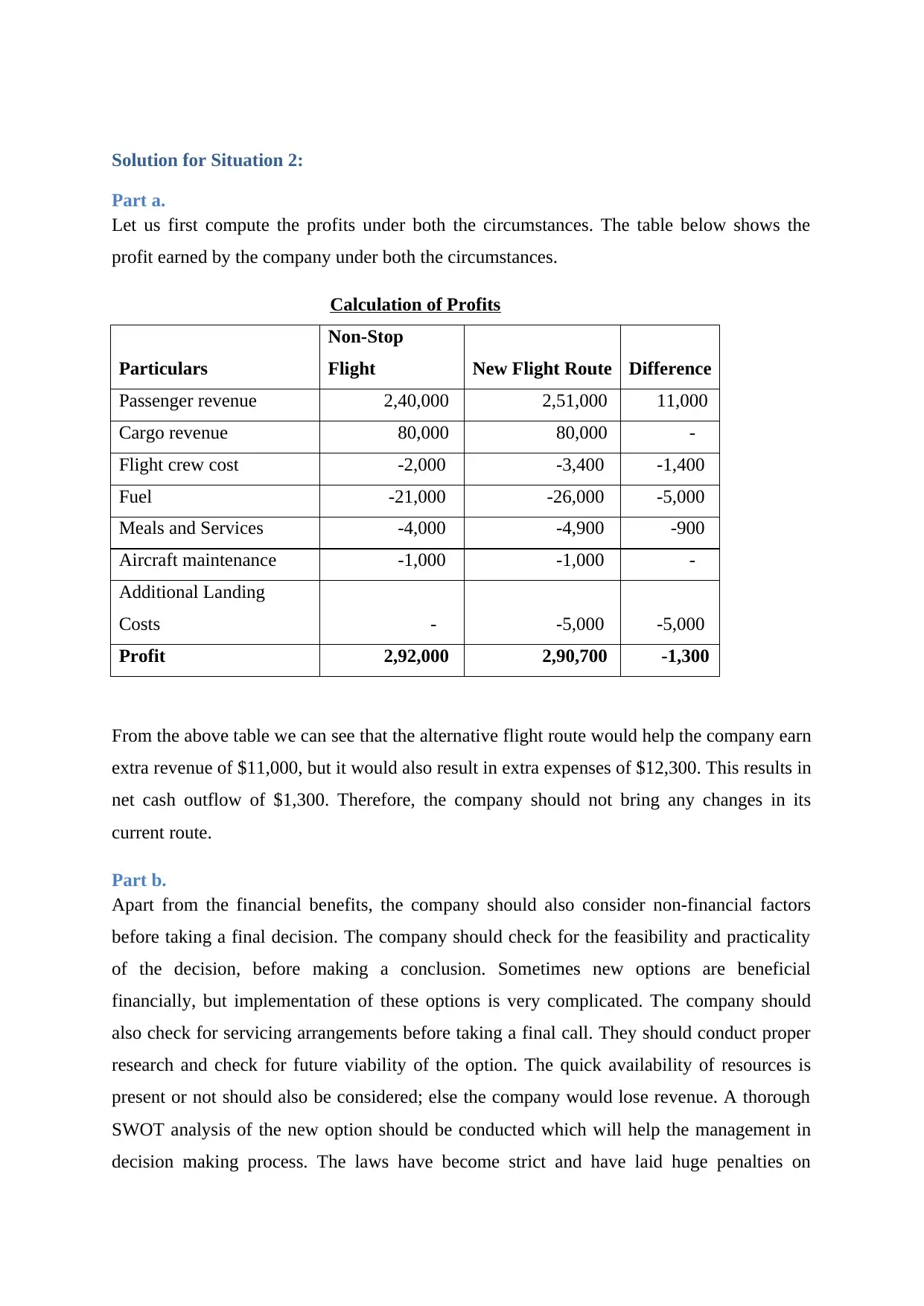
Solution for Situation 2:
Part a.
Let us first compute the profits under both the circumstances. The table below shows the
profit earned by the company under both the circumstances.
Calculation of Profits
Particulars
Non-Stop
Flight New Flight Route Difference
Passenger revenue 2,40,000 2,51,000 11,000
Cargo revenue 80,000 80,000 -
Flight crew cost -2,000 -3,400 -1,400
Fuel -21,000 -26,000 -5,000
Meals and Services -4,000 -4,900 -900
Aircraft maintenance -1,000 -1,000 -
Additional Landing
Costs - -5,000 -5,000
Profit 2,92,000 2,90,700 -1,300
From the above table we can see that the alternative flight route would help the company earn
extra revenue of $11,000, but it would also result in extra expenses of $12,300. This results in
net cash outflow of $1,300. Therefore, the company should not bring any changes in its
current route.
Part b.
Apart from the financial benefits, the company should also consider non-financial factors
before taking a final decision. The company should check for the feasibility and practicality
of the decision, before making a conclusion. Sometimes new options are beneficial
financially, but implementation of these options is very complicated. The company should
also check for servicing arrangements before taking a final call. They should conduct proper
research and check for future viability of the option. The quick availability of resources is
present or not should also be considered; else the company would lose revenue. A thorough
SWOT analysis of the new option should be conducted which will help the management in
decision making process. The laws have become strict and have laid huge penalties on
Part a.
Let us first compute the profits under both the circumstances. The table below shows the
profit earned by the company under both the circumstances.
Calculation of Profits
Particulars
Non-Stop
Flight New Flight Route Difference
Passenger revenue 2,40,000 2,51,000 11,000
Cargo revenue 80,000 80,000 -
Flight crew cost -2,000 -3,400 -1,400
Fuel -21,000 -26,000 -5,000
Meals and Services -4,000 -4,900 -900
Aircraft maintenance -1,000 -1,000 -
Additional Landing
Costs - -5,000 -5,000
Profit 2,92,000 2,90,700 -1,300
From the above table we can see that the alternative flight route would help the company earn
extra revenue of $11,000, but it would also result in extra expenses of $12,300. This results in
net cash outflow of $1,300. Therefore, the company should not bring any changes in its
current route.
Part b.
Apart from the financial benefits, the company should also consider non-financial factors
before taking a final decision. The company should check for the feasibility and practicality
of the decision, before making a conclusion. Sometimes new options are beneficial
financially, but implementation of these options is very complicated. The company should
also check for servicing arrangements before taking a final call. They should conduct proper
research and check for future viability of the option. The quick availability of resources is
present or not should also be considered; else the company would lose revenue. A thorough
SWOT analysis of the new option should be conducted which will help the management in
decision making process. The laws have become strict and have laid huge penalties on

companies incurring environmental costs. The management should also take into
consideration the environmental costs to be incurred due to the new option, before taking a
final decision. Therefore, all the points mentioned above should also be considered along
with the financial results.
consideration the environmental costs to be incurred due to the new option, before taking a
final decision. Therefore, all the points mentioned above should also be considered along
with the financial results.
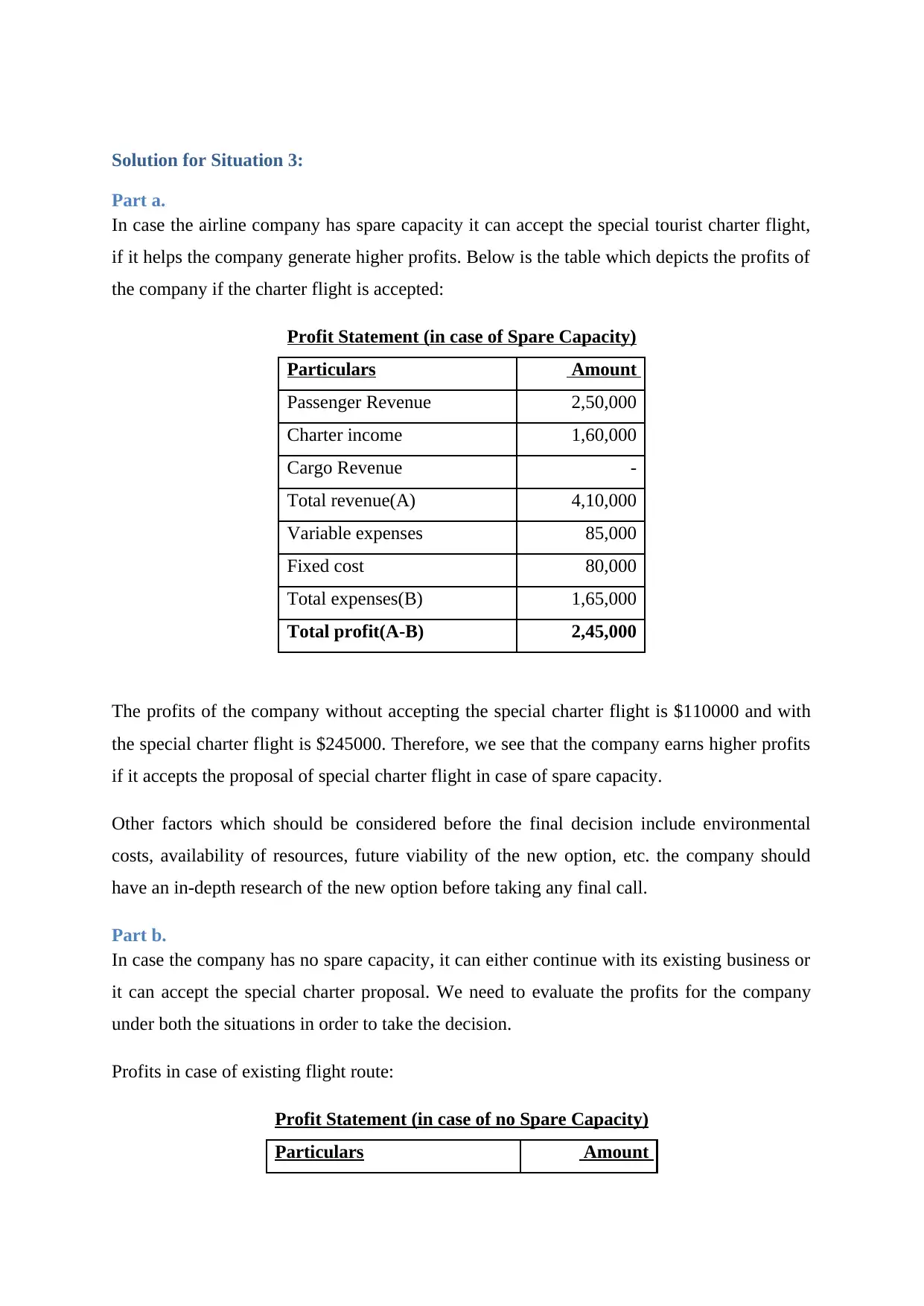
Solution for Situation 3:
Part a.
In case the airline company has spare capacity it can accept the special tourist charter flight,
if it helps the company generate higher profits. Below is the table which depicts the profits of
the company if the charter flight is accepted:
Profit Statement (in case of Spare Capacity)
Particulars Amount
Passenger Revenue 2,50,000
Charter income 1,60,000
Cargo Revenue -
Total revenue(A) 4,10,000
Variable expenses 85,000
Fixed cost 80,000
Total expenses(B) 1,65,000
Total profit(A-B) 2,45,000
The profits of the company without accepting the special charter flight is $110000 and with
the special charter flight is $245000. Therefore, we see that the company earns higher profits
if it accepts the proposal of special charter flight in case of spare capacity.
Other factors which should be considered before the final decision include environmental
costs, availability of resources, future viability of the new option, etc. the company should
have an in-depth research of the new option before taking any final call.
Part b.
In case the company has no spare capacity, it can either continue with its existing business or
it can accept the special charter proposal. We need to evaluate the profits for the company
under both the situations in order to take the decision.
Profits in case of existing flight route:
Profit Statement (in case of no Spare Capacity)
Particulars Amount
Part a.
In case the airline company has spare capacity it can accept the special tourist charter flight,
if it helps the company generate higher profits. Below is the table which depicts the profits of
the company if the charter flight is accepted:
Profit Statement (in case of Spare Capacity)
Particulars Amount
Passenger Revenue 2,50,000
Charter income 1,60,000
Cargo Revenue -
Total revenue(A) 4,10,000
Variable expenses 85,000
Fixed cost 80,000
Total expenses(B) 1,65,000
Total profit(A-B) 2,45,000
The profits of the company without accepting the special charter flight is $110000 and with
the special charter flight is $245000. Therefore, we see that the company earns higher profits
if it accepts the proposal of special charter flight in case of spare capacity.
Other factors which should be considered before the final decision include environmental
costs, availability of resources, future viability of the new option, etc. the company should
have an in-depth research of the new option before taking any final call.
Part b.
In case the company has no spare capacity, it can either continue with its existing business or
it can accept the special charter proposal. We need to evaluate the profits for the company
under both the situations in order to take the decision.
Profits in case of existing flight route:
Profit Statement (in case of no Spare Capacity)
Particulars Amount
Paraphrase This Document
Need a fresh take? Get an instant paraphrase of this document with our AI Paraphraser
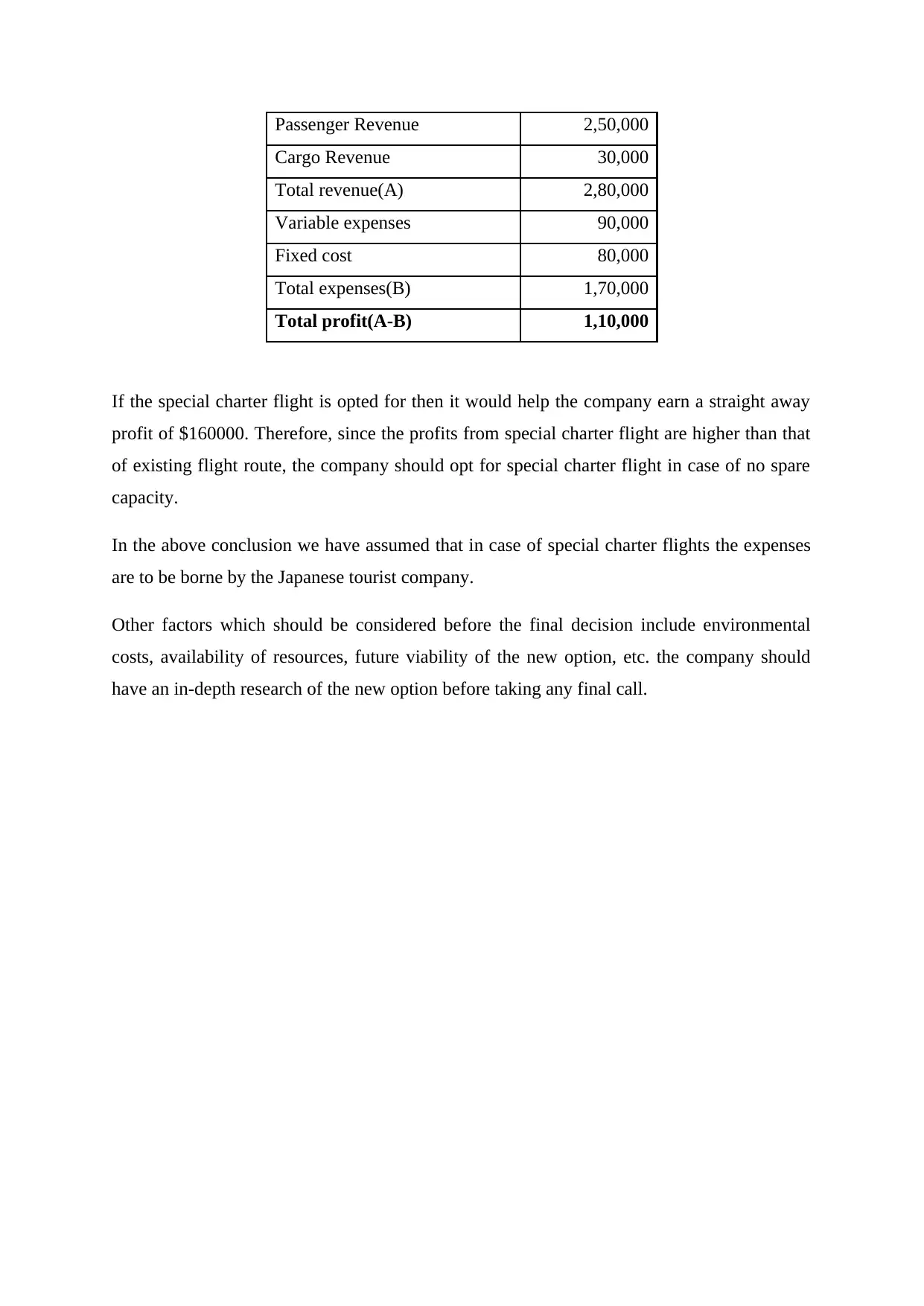
Passenger Revenue 2,50,000
Cargo Revenue 30,000
Total revenue(A) 2,80,000
Variable expenses 90,000
Fixed cost 80,000
Total expenses(B) 1,70,000
Total profit(A-B) 1,10,000
If the special charter flight is opted for then it would help the company earn a straight away
profit of $160000. Therefore, since the profits from special charter flight are higher than that
of existing flight route, the company should opt for special charter flight in case of no spare
capacity.
In the above conclusion we have assumed that in case of special charter flights the expenses
are to be borne by the Japanese tourist company.
Other factors which should be considered before the final decision include environmental
costs, availability of resources, future viability of the new option, etc. the company should
have an in-depth research of the new option before taking any final call.
Cargo Revenue 30,000
Total revenue(A) 2,80,000
Variable expenses 90,000
Fixed cost 80,000
Total expenses(B) 1,70,000
Total profit(A-B) 1,10,000
If the special charter flight is opted for then it would help the company earn a straight away
profit of $160000. Therefore, since the profits from special charter flight are higher than that
of existing flight route, the company should opt for special charter flight in case of no spare
capacity.
In the above conclusion we have assumed that in case of special charter flights the expenses
are to be borne by the Japanese tourist company.
Other factors which should be considered before the final decision include environmental
costs, availability of resources, future viability of the new option, etc. the company should
have an in-depth research of the new option before taking any final call.
1 out of 8
Related Documents
Your All-in-One AI-Powered Toolkit for Academic Success.
+13062052269
info@desklib.com
Available 24*7 on WhatsApp / Email
![[object Object]](/_next/static/media/star-bottom.7253800d.svg)
Unlock your academic potential
© 2024 | Zucol Services PVT LTD | All rights reserved.




